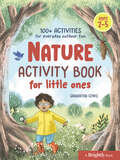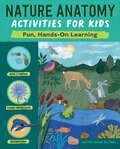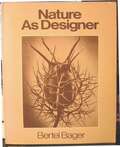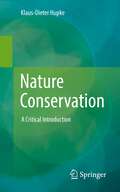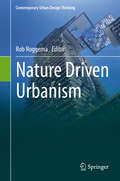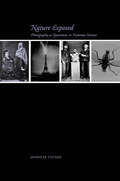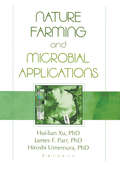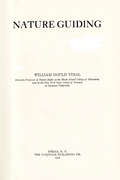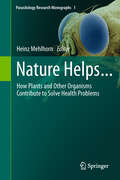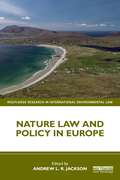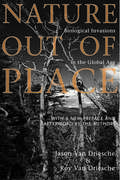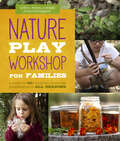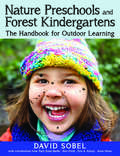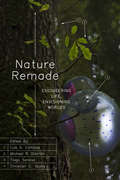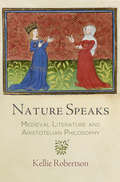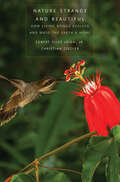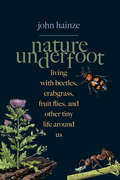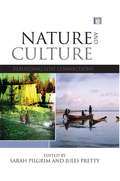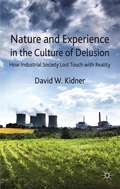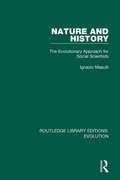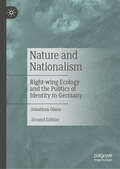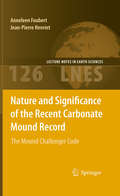- Table View
- List View
Nature Activity Book for Little Ones: 100+ Activities for Everyday Outdoor Fun
by Samantha LewisIntroduce your little one to the wonders of nature with 100+ outdoor learning activities!Give your child all the benefits of nature with this activity book designed for children ages 2-5. Whether you&’re planning an afternoon in a local park, a day in the backyard, or a morning hike in a nature preserve, you and your child will find more than 100 ideas in these pages for observing, exploring, creating, and playing in nature.Nature Activity Book for Little Ones features: • 100+ outdoor activities for kids ages 2-5, geared toward their interests and developmental milestones—with little or no preparation required • Bonus activities for additional learning, including numbers, letters, shapes, and colors • School prep: the activities teach problem-solving, communication, and responsibility, important skills for school succes • Less screen time and more nature time together to fuel your child&’s curiosity and creativity and help them build an early connection with natureBest of all, this entertaining book provides more than a hundred ways to keep your child moving and occupied and for you to bond with your child, all in nature!
Nature All Around Us: A Guide to Urban Ecology
by Beatrix Beisner, Christian Messier, and Luc-Alain GiraldeauIt’s easy to stand in awe of a city’s impressive skyline, marveling at its buildings reaching for the clouds and its vast network of roadways and train lines crisscrossing in every direction. It can often seem like everything in a city is man-made, all concrete, steel, and glass. But even the asphalt jungle is not all asphalt—a sidewalk’s cracks are filled with nature, if we know where and how to look. To aid us in this quest is Nature All Around Us, which will help us to recognize (and look after) the natural world we traipse through in our daily lives. Nature All Around Us uses the familiar—such as summer Sundays humming with lawn mowers, gray squirrels foraging in planters, and flocks of pigeons—in order to introduce basic ecological concepts. In twenty-five short chapters organized by scale, from the home to the neighborhood to the city at large, it offers a subtle and entertaining education in ecology sure to inspire appreciation and ultimately stewardship of the environment. Various ecological concepts that any urban dweller might encounter are approachably examined, from understanding why a squirrel might act aggressively towards its neighbor to how nutrients and energy contained within a discarded apple core are recycled back into the food chain. Streaming through the work is an introduction to basic ecology, including the dangers of invasive species and the crucial role played by plants and trees in maintaining air quality. Taken as a whole, Nature All Around Us is an unprecedented field guide to the ecology of the urban environment that invites us to look at our towns, cities, and even our backyards through the eyes of an ecologist. It is an entertaining, educational, and inspiring glimpse into nature in seemingly unnatural settings, a reminder that we don’t have to trek into the wild to see nature—we just have to open our eyes.
Nature Anatomy Activities for Kids: Fun, Hands-On Learning (Anatomy Activities for Kids)
by Kristine BrownThink like a scientist and search like an explorer with this illustrated nature guide for kids ages 8 to 12Get ready to explore the sky above, the ground below, and all the plants and creatures in between! Made just for kids, this nature anatomy book teaches you about the incredible forces and living things that exist in nature.You'll dig in to tons of different topics—from naming the layers of the atmosphere to learning the parts of a flower—and try out fun activities like creating a mini cloud and raising a tadpole. As you explore the natural world around you, you'll become a real scientist by asking questions, imagining outcomes, testing your ideas, and then writing down what you discover.Nature Anatomy Activities for Kids includes:5 Subjects, 20 lessons—Dive in to different chapters for the earth, the sky, water, plants, and animals. Every chapter includes multiple lessons about the topic, with a new activity and a journal prompt for each.Journal like a scientist—Use your own blank journal to answer prompts and take notes so you can write and draw everything you observe or note any questions you want to find an answer for.Detailed illustrations—Colorful pictures and diagrams make this nature anatomy book fun to use and get kids excited about the anatomy of plants, animals, ecosystems, and landscapes.Get outside and explore with this book of nature anatomy activities that opens up a whole new world of learning.
Nature As Designer: A Botanical Art Study
by Bertel BagerFrom Foreword: "...Dr. Bertel Bager, who has written, collected and assorted the material for this book over a long period of years, is a man who has long been associated with both art and nature. In addition to his position of chief surgeon at one of the largest hospitals in Sweden, he has made the study of design and nature his avocation. He annually enjoys tours of discovery in the Swedish countryside, searching the grasses and thistles, mosses and lichens, usually finding something worth collecting and meditating upon. Not primarily interested in bright colors, he is fasxcinated by meadows at the time they hav ebeen deserted by butterflies, and by mountain forests, the realm of timeless lichens and mosses. Long after the meadow has lost its summer glory, he seeks the unappreciated - the fruits and seedpods - swaying and rustling in the autumn winds. When winter comes, he stands meditating upon the expressive play of shadows of dead plants on the snow. What Bager is seeking above all, is the beauty of form in nature. Displayed in many cabinets is his treasured collection of specimens amassed over the years, much like a gallery, showing the fascinating forms of simple things in nature and emphasizing the theme, 'Nature as Designer.' This volume is a guided tour through part of these treasures but is meant to stimulate interest in form and to please the eye, which is the primary purpose of an illustrated book." Softcover, 8 x 10 inches, 176 pages, 191 black and white photographs.
Nature Conservation: A Critical Introduction
by Klaus-Dieter HupkeMany things happen in nature reserves that are contradictory at first glance. For example, flower meadows are mown down during maintenance work, even though all the plants growing there are protected. Elsewhere, protected reed beds are burnt down in a fen or the top layer of soil is removed with bulldozers in a dune conservation area. Still other areas are to remain completely untouched by human intervention. The author Klaus-Dieter Hupke shows the different strategies of nature conservation. He also shows that nature conservation is mostly not exactly what the term says in essence: "protection of nature". On the contrary, in Central Europe nature conservation areas are predominantly the relics of old agricultural and thus cultural landscapes. Often, aesthetic aspects of a landscape section are also in the foreground when designating it as a natural monument or nature reserve. Moreover, nature conservation runs the risk of becoming a substitute action and an alibi for a still growing destruction of traditional and near-natural landscape systems in Central Europe as well as globally.The updated second edition now explicitly includes the consequences of climate change for nature conservation and has also incorporated a stronger reference to Austria as well as to the central Alpine region in some places for the relevant readers.
Nature Driven Urbanism (Contemporary Urban Design Thinking)
by Rob RoggemaThis book discusses the way that a nature-driven approach to urbanism can be applied at each of the urban scales; architectural design, urban design of neighborhoods, city planning and landscape architecture, and at the city and regional scales. At all levels nature-driven approaches to design and planning add to the quality of the built structure and furthermore to the quality of life experienced by people living in these environments. To include nature and greening to built structures is a good starting point and can add much value. The chapter authors have fiducia in giving nature a fundamental role as an integrated network in city design, or to make nature the entrance point of the design process, and base the design on the needs and qualities of nature itself. The highest existence of nature is a permanent ecosystem which endures stressors and circumstances for a prolonged period. In an urban context this is not always possible and temporality is an interesting concept explored when nature is not a permanent feature. The ecological contribution to the environment, and indirect dispersion of species, from a temporary location will, overall add biodiversity to the entire system.
Nature Exposed: Photography as Eyewitness in Victorian Science
by Jennifer TuckerIn Nature Exposed, Jennifer Tucker studies the intersecting trajectories of photography and modern science in late Victorian Britain. She examines the role of photograph as witness in scientific investigation and explores the interplay between photography and scientific authority. Almost immediately after the invention of photography in 1839, photographs were characterized as offering objective access to reality—unmediated by human agency, political ties, or philosophy. This mechanical objectivity supposedly eliminated judgment and interpretation in reporting and picturing scientific results. But photography is a labor-intensive process that allows for, and sometimes requires, manipulation. In the late nineteenth century, the nature of this new technology sparked a complex debate about scientific practices and the value of the photographic images in the production and dissemination of scientific knowledge. Recovering the controversies and commentary surrounding the early creation of scientific photography and drawing on a wide range of new sources and critical theories, Tucker establishes a greater understanding of the rich visual culture of Victorian science and alternative forms of knowledge, including psychical research.
Nature Farming and Microbial Applications
by Hiu-lian Xu Hiroshi Umemura James F. Parr JrProduce more abundant, high-quality crops with the information you'll find in this book!Recent concerns over environmental pollution and food quality degradation caused by the excessive use of chemicals have prompted scientists and policymakers to re-evaluate modern agricultural processes and search for alternatives that will aid in the production of healthy foods and the protection of our environment. Nature Farming and Microbial Applications summarizes current research in the field, highlighting unique practices such as the use of microbial inoculants and various alternatives to chemical fertilizers and pesticides. The principles of nature farming, as set forth by Japanese philosopher Mokichi Okada, must fulfill these requirements: producing safe and nutritious food that promotes good health providing economic and spiritual benefits to both producers and consumers being sustainable and easily practiced conserving and protecting the environment producing sufficient high-quality food for an expanding world populationTo this end, Nature Farming and Microbial Applications addresses issues of concern to organic farmers, including: soil fertility pest control effective microorganisms photosynthesis transpiration plant-water relations stress resistance of growing cropsThis well-referenced volume contains unique and original methods of modeling and analysis. It will be used again and again as a reference source for students and researchers.
Nature Guiding
by William Gould VinalNature Guiding is the science of inculcating nature enthusiasm, nature principles, and nature facts into the spirit of individuals. "Doing" nature-study means observing, wondering, and solving problems. It could include collecting, building, measuring, painting, planning, writing, touching, experimenting or any of a wide range of other activities. Most importantly, it allows children to be "original investigators."This book is intended as a resource for teachers and students engaged in nature study at summer camps and in schools. William Gould Vinal believed that the teacher of nature study should be "in sympathy with the simple life and the country way," that the nature study should emphasize observation of the interactions of plants and animals in their environment, and not be reduced to matters of taxonomy and anatomy. In Nature Guiding, he offers advice to camp counselors and school teachers on incorporating nature study into everyday activities, as well as suggestions for parents and others about using visits to state and national parks to teach nature lore.
Nature Helps...
by Heinz MehlhornNature helps... of course at first itself by developing measures that give bacteria, fungi, plants and animals a chance to be successful in their struggle for life. As a latecomer on Earth, Homo sapiens was gifted with some droplets of the divine spirit of recognition and thus became able to observe, to analyse and recombine skills of other living beings and to use them for his overwhelming career over the last 10,000 years. Of course fungi, plants, animals and even bacteria were primarily used by mankind as food or as lifestyle products such as beer, but soon it became clear that there was much more potential hidden in these organisms and that they could be used for other purposes, too. Extracts of plants and fungi were recognized as powerful remedies, as medicines, as insecticides or acarizides, as repellents against parasites or even as weapons, e.g. when poisonous compounds from frogs or plants were applied to arrowheads. Over the last 110 years the pharmaceutical industry has often simulated nature by analyzing complex organic substances taken from living organisms and then producing by synthesis absolutely pure compounds, which mostly consisted of only one single active substance. These products had the advantage of acting against precisely one target and thus produced fewer possible side effects than the complex plant extracts. However, the more serious side effect was that disease agents could develop resistances to pure medicinal products much more easily. Thus after 70 years of excellent prospects for chemotherapy, some dark clouds appeared and quickly gathered, so that several therapeutic remedies now no longer work. Therefore in many countries - especially in those where the pure chemotherapeutics are too expensive for the poor population - the cry "back to nature" is becoming louder and louder. This has led to an enormous increase of studies that again use natural extracts as remedies in the fight against diseases. The present book summarizes examples of promising aspects in a broad spectrum of applications and shows how extracts derived from bacteria, marine organisms, plants or even animals may help to treat infectious diseases, how such organisms may keep away parasites and pests from the bodies of plants or animals, including humans, and how they can be used directly to aid in diagnosis, promote wound healing and even to help catch criminals. These 15 chapters offer not only basic research on these different fields, but also show how useful and effective products can be developed from research.
Nature Law and Policy in Europe (Routledge Research in International Environmental Law)
by Andrew L. R. JacksonThis volume considers current and future challenges for nature law and policy in Europe. Following the Fitness Check evaluation of the Birds and Habitats Directives, in 2017 the EU adopted an Action Plan for nature, people and the economy to rapidly improve the Directives’ implementation and accelerate progress towards the EU's biodiversity targets for 2020. More recently, the EU has adopted a Biodiversity Strategy for 2030 and proposed an EU Nature Restoration Law. This book makes a timely contribution by examining the current state of play in light of recent and historical developments, as well as the post-2020 nature law and policy landscape. While evidence suggests that Natura 2000 and the Habitats and Birds Directives have delivered conservation benefits for wildlife in Europe, biodiversity loss continues apace. The book reviews the requirements for an effective international nature conservation system, with reference to the Birds and Habitats Directives. It examines regulatory regimes, current legal issues in the fields of site protection and species protection, the protection of areas outside Natura 2000, recent developments in the EU and the UK, including the implications of Brexit, agriculture and nature conservation, litigation, science and access to justice. Written by leading experts in the field, from a range of stakeholder groups, the volume draws on diverse experiences as well as providing interdisciplinary perspectives. This volume will be essential reading for students, scholars, practitioners, NGOs and policy-makers interested in European environmental policy and law, including for example lawyers, ecologists, environmental scientists, political scientists, natural resource managers, planners and civil servants.
Nature Out of Place: Biological Invasions In The Global Age
by Jason Van Driesche Roy Van DriescheThough the forests are still green and the lakes full of water, an unending stream of invasions is changing many ecosystems around the world from productive, tightly integrated webs of native species to loose assemblages of stressed native species and aggressive invaders. The earth is becoming what author David Quammen has called a "planet of weeds." Nature Out of Place brings this devastating but overlooked crisis to the forefront of public consciousness by offering a fascinating exploration of its causes and consequences, along with a thoughtful and practical consideration of what can be done about it. The father and son team of Jason and Roy Van Driesche offer a unique combination of narratives that highlight specific locations and problems along with comprehensive explanations of the underlying scientific and policy issues.Chapters examine Hawaii, where introduced feral pigs are destroying the islands' native forests; zebra mussel invasion in the rivers of Ohio; the decades-long effort to eradicate an invasive weed on the Great Plains; and a story about the restoration of both ecological and human history in an urban natural area. In-depth background chapters explain topics ranging from how ecosystems become diverse, to the characteristics of effective invaders, to procedures and policies that can help prevent future invasions. The book ends with a number of specific suggestions for ways that individuals can help reduce the impacts of invasive species, and offers resources for further information.By bringing the problem of invasive species to life for readers at all levels, Nature Out of Place will play an essential role in the vital effort to raise public awareness of this ongoing ecological crisis.
Nature Play Workshop for Families: A Guide to 40+ Outdoor Learning Experiences in All Seasons (Workshop For Kids Ser.)
by Monica Wiedel-Lubinski Karen MadiganNational Outdoor Book Award Winner: A fun, practical guide to outdoor play that sparks a connection to nature vital to children’s healthy development.Today children and families are often plugged into electronics and disconnected from direct experiences in nature. This beautifully photographed resource offers tangible approaches to nature-based learning and play for children. Parents and teachers can discover the benefits of outdoor learning and simple ways to facilitate unplugged nature connection in every season.Inspired by nature preschools, forest kindergartens, and forest school models the world over, this guide also includes “Voices from the Field” with advice from experienced nature-based educators. Balancing nature play experiences with hands-on projects using natural materials, it’s an ideal jumping off point for immersive nature play. Examples include: Wildlife observation and trackingNature sounds, songs, and poetryGardening and cooking with wild ediblesPrintmaking, charcoal drawing, dyeing, and shadow playJournaling inspired by nature“Voices from the Field” includes more ideas and tips contributed by leading educators, including:Sally Anderson, Sol Forest School, Tijeras, New Mexico * Yash Bhagwanji, Florida Atlantic University * Lauren Brown, Asheville Farmstead School * Peter Dargatz, Woodside Elementary School, Sussex, Wisconsin * Monica French, Wild Haven Forest Preschool and Childcare, Baltimore, Maryland * Patricia Leon, Miami Nature Playschool * Sheila William Ridge, Shirley G. Moore Lab School, Institute of Child Development, University of Minnesota * Beth Savitz, Irvine Nature Center, Owings Mills, Maryland * Maria Soboleski, New Mexico School for the Deaf * Paige Vonder Haar, Bunnell House Early Childhood Lab School, Fairbanks, Alaska * Susie Wirth, Arbor Day Foundation and Dimensions Foundation
Nature Preschools and Forest Kindergartens
by David Sobel Patti Bailie Ann Stires Ken Finch Erin KennyEnvironmental education expert David Sobel joins with a variety of colleagues to share their experiences and steps for creating a successful forest kindergarten program. Nature Preschools and Forest Kindergartens walks you through the European roots of the concept to the recent resurgence of these kinds of programs in North America.Going well beyond a history lesson, these experts provide the framework to understand the concepts and build a learning community that stimulates curiosity and inquisitiveness in a natural environment. This helpful guide provides the curriculum, ideas, and guidance needed to foster special gifts in children. It also gives you the nuts and bolts of running a successful nature preschool business, such as potential obstacles, staff and curriculum design, best practices for success, site and facility management, and business planning.Nature Preschools and Forest Kindergartens provides the mentorship and guidance to become a leader in nature-based education.David Sobel has spent the last twenty-five years working in the field of child development, place-based education, and parenting with nature. He currently serves as senior faculty in the education department at Antioch University New England in Keene, New Hampshire. His expertise and passion have led him to authoring seven books and being identified as one of the "gurus and rock stars of environmental education" by Teacher magazine.
Nature Remade: Engineering Life, Envisioning Worlds (Convening Science: Discovery at the Marine Biological Laboratory)
by Christian C. Young“Engineering” has firmly taken root in the entangled bank of biology even as proposals to remake the living world have sent tendrils in every direction, and at every scale. Nature Remade explores these complex prospects from a resolutely historical approach, tracing cases across the decades of the long twentieth century. These essays span the many levels at which life has been engineered: molecule, cell, organism, population, ecosystem, and planet. From the cloning of agricultural crops and the artificial feeding of silkworms to biomimicry, genetic engineering, and terraforming, Nature Remade affirms the centrality of engineering in its various forms for understanding and imagining modern life. Organized around three themes—control and reproduction, knowing as making, and envisioning—the chapters in Nature Remade chart different means, scales, and consequences of intervening and reimagining nature.
Nature Remade: Engineering Life, Envisioning Worlds (Convening Science: Discovery at the Marine Biological Laboratory)
by Christian C. Young“Engineering” has firmly taken root in the entangled bank of biology even as proposals to remake the living world have sent tendrils in every direction, and at every scale. Nature Remade explores these complex prospects from a resolutely historical approach, tracing cases across the decades of the long twentieth century. These essays span the many levels at which life has been engineered: molecule, cell, organism, population, ecosystem, and planet. From the cloning of agricultural crops and the artificial feeding of silkworms to biomimicry, genetic engineering, and terraforming, Nature Remade affirms the centrality of engineering in its various forms for understanding and imagining modern life. Organized around three themes—control and reproduction, knowing as making, and envisioning—the chapters in Nature Remade chart different means, scales, and consequences of intervening and reimagining nature.
Nature Remade: Engineering Life, Envisioning Worlds (Convening Science: Discovery at the Marine Biological Laboratory)
by Christian C. Young“Engineering” has firmly taken root in the entangled bank of biology even as proposals to remake the living world have sent tendrils in every direction, and at every scale. Nature Remade explores these complex prospects from a resolutely historical approach, tracing cases across the decades of the long twentieth century. These essays span the many levels at which life has been engineered: molecule, cell, organism, population, ecosystem, and planet. From the cloning of agricultural crops and the artificial feeding of silkworms to biomimicry, genetic engineering, and terraforming, Nature Remade affirms the centrality of engineering in its various forms for understanding and imagining modern life. Organized around three themes—control and reproduction, knowing as making, and envisioning—the chapters in Nature Remade chart different means, scales, and consequences of intervening and reimagining nature.
Nature Speaks: Medieval Literature and Aristotelian Philosophy (The Middle Ages Series)
by Kellie RobertsonWhat does it mean to speak for nature? Contemporary environmental critics warn that giving a voice to nonhuman nature reduces it to a mere echo of our own needs and desires; they caution that it is a perverse form of anthropocentrism. And yet nature's voice proved a powerful and durable ethical tool for premodern writers, many of whom used it to explore what it meant to be an embodied creature or to ask whether human experience is independent of the natural world in which it is forged.The history of the late medieval period can be retold as the story of how nature gained an authoritative voice only to lose it again at the onset of modernity. This distinctive voice, Kellie Robertson argues, emerged from a novel historical confluence of physics and fiction-writing. Natural philosophers and poets shared a language for talking about physical inclination, the inherent desire to pursue the good that was found in all things living and nonliving. Moreover, both natural philosophers and poets believed that representing the visible world was a problem of morality rather than mere description. Based on readings of academic commentaries and scientific treatises as well as popular allegorical poetry, Nature Speaks contends that controversy over Aristotle's natural philosophy gave birth to a philosophical poetics that sought to understand the extent to which the human will was necessarily determined by the same forces that shaped the rest of the material world.Modern disciplinary divisions have largely discouraged shared imaginative responses to this problem among the contemporary sciences and humanities. Robertson demonstrates that this earlier worldview can offer an alternative model of human-nonhuman complementarity, one premised neither on compulsory human exceptionalism nor on the simple reduction of one category to the other. Most important, Nature Speaks assesses what is gained and what is lost when nature's voice goes silent.
Nature Strange and Beautiful: How Living Beings Evolved and Made the Earth a Home
by Christian Ziegler Egbert Giles LeighA beautifully written exploration of how cooperation shaped life on earth, from its single-celled beginnings to complex human societiesIn this rich, wide-ranging, beautifully illustrated volume, Egbert Leigh explores the results of billions of years of evolution at work. Leigh, who has spent five decades on Panama&’s Barro Colorado Island reflecting on the organization of various amazingly diverse tropical ecosystems, now shows how selection on &“selfish genes&” gives rise to complex modes of cooperation and interdependence.With the help of such artists as the celebrated nature photographer Christian Ziegler, natural history illustrator Deborah Miriam Kaspari, and Damond Kyllo, Leigh explains basic concepts of evolutionary biology, ranging from life&’s single-celled beginnings to the complex societies humans have formed today. The book covers a range of topics, focusing on adaptation, competition, mutualism, heredity, natural selection, sexual selection, genetics, and language. Leigh&’s reflections on evolution, competition, and cooperation show how the natural world becomes even more beautiful when viewed in the light of evolution.
Nature Underfoot: Living with Beetles, Crabgrass, Fruit Flies, and Other Tiny Life Around Us
by John HainzeAn informed and heartfelt tribute to commonly unappreciated plants, insects, and other tiny creatures that reconsiders humanity&’s relationship to nature Fruit flies, silverfish, dandelions, and crabgrass are the bane of many people and the target of numerous chemical and physical eradication efforts. In this compelling reassessment of the relationship between humans and the natural world, John Hainze—an entomologist and former pesticide developer—considers the fascinating and bizarre history of how these so-called invasive or unwanted pests and weeds have coevolved with humanity and highlights the benefits of a greater respect and moral consideration toward these organisms. With deep insight into the lives of the underappreciated and often reviled creatures that surround us, Hainze&’s accessible and engaging natural history draws on ethics, religion, and philosophy as he passionately argues that creepy crawlies and unwanted plants deserve both empathy and accommodation as partners dwelling with us on earth.
Nature and Culture: Rebuilding Lost Connections
by Jules Pretty Sarah PilgrimThere is a growing recognition that the diversity of life comprises both biological and cultural diversity. But this division is not universal and, in many cases, has been deepened by the common disciplinary divide between the natural and social sciences and our apparent need to manage and control nature. This book goes beyond divisive definitions and investigates the bridges linking biological and cultural diversity. The international team of authors explore the common drivers of loss, and argue that policy responses should target both forms of diversity in a novel integrative approach to conservation, thus reducing the gap between science, policy and practice. While conserving nature alongside human cultures presents unique challenges, this book forcefully shows that any hope for saving biological diversity is predicated on a concomitant effort to appreciate and protect cultural diversity.
Nature and Experience in the Culture of Delusion: How Industrial Society Lost Touch with Reality
by David W. KidnerIndustrialism has alienated us from nature, disconnected us from our own embodiment, and blinded us to the character of the technological society we have ourselves have produced. This book brings together ideas and research from both social and natural sciences to throw light on the hidden dimensions of industrial life, showing how the emerging global economic system has dissolved our embodied subjectivity into industrial processes. The symbolic abilities that have allowed us to dominate all other creatures have now entrapped us within systems that we do not understand and have little control over, making us as vulnerable to the extension of economic and technological ideologies as our ancestors were to the natural threats that surrounded them. If we are to regain our humanity and integrity, the essential first step, outlined in this book, is to recognise and challenge the sources of our own powerlessness.
Nature and History: The Evolutionary Approach for Social Scientists (Routledge Library Editions: Evolution #6)
by Ignazio MasulliOriginally published in 1990, Nature and History examines how Darwin’s theory of evolution has been expanded by scholars and researchers to include virtually every scientific discipline. The book presents a morphological analysis of historical and social sciences – sciences which have traditionally have been viewed as too random in their progressions to conform to a model. Through the evaluation of empirical and factual evidence, the book builds a case for an evolutionary paradigm which encompasses both natural and social sciences, and presents the form’s adaptiveness in working historical models.
Nature and Nationalism: Right-wing Ecology and the Politics of Identity in Germany
by Jonathan OlsenIn this new edition of his now classic 1999 book, Jonathan Olsen explores the relationship between the far right and the environment, or what he terms “right-wing ecology.” Arguing that radical environmentalism is not exclusively a domain of the left, Olsen shows how many of Germany's far right parties and groups ground their ecological ideology in an anti-universalist anthropology which sees human beings as naturally 'rooted' in specific nations and cultural traditions. Pollution in this discourse signifies not only the disruption of the natural world, but the social world as well, thus providing an environmental justification for an anti-immigrant politics which finds resonance outside the specific milieu of the far right. A rigorously theoretical book, Nature and Nationalism challenges our understanding of the deeply ambiguous ways in which 'nature' functions to legitimate a wide variety of political ideas.
Nature and Significance of the Recent Carbonate Mound Record
by Jean-Pierre Henriet Anneleen FoubertNo books are available on the market describing recent carbonate mounds along the European continental margins and deciphering step by step their internal structure. The first results of IODP Expedition 307 "Modern Carbonate Mounds: Porcupine Drilling" are published in Ferdelman, T.G., Kano, A., Williams, T., Henriet, J.-P., and the Expedition 307 Scientists, 2006. Proc. IODP, 307: Washington, DC (Integrated Ocean Drilling Program Management International, Inc.). doi:10.2204/iodp.proc.307.2006. However, these proceedings do not give an overview of the existing knowledge on carbonate mounds and do not include detailed post-cruise analysis and advanced interpretations.
